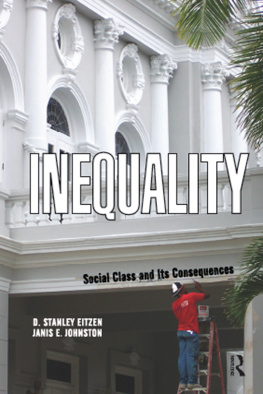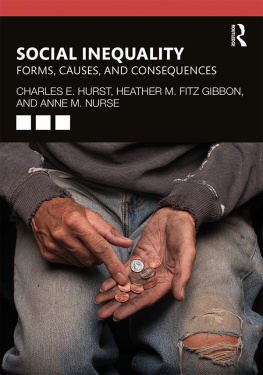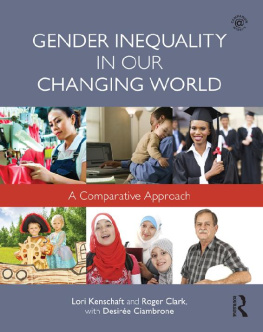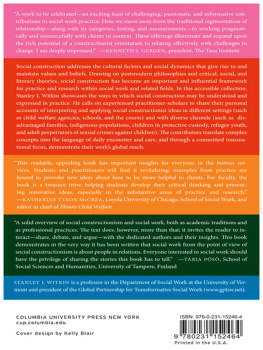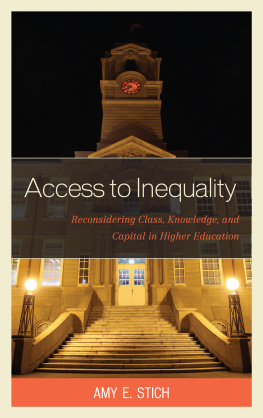INEQUALITY
INEQUALITY
SOCIAL CLASS AND ITS CONSEQUENCES
edited by
D. Stanley Eitzen and Janis E. Johnston
Due to space limitations on this page, source notes and permission credits for all of the readings in this volume appear in the Credits section beginning on page 217.
First published 2007 by Paradigm Publishers
Published 2016 by Routledge
2 Park Square, Milton Park, Abingdon, Oxon OX14 4RN
711 Third Avenue, New York, NY 10017, USA
Routledge is an imprint of the Taylor & Francis Group, an informa business
Copyright 2007, Taylor & Francis.
All rights reserved. No part of this book may be reprinted or reproduced or utilised in any form or by any electronic, mechanical, or other means, now known or hereafter invented, including photocopying and recording, or in any information storage or retrieval system, without permission in writing from the publishers.
Notice:
Product or corporate names may be trademarks or registered trademarks, and are used only for identification and explanation without intent to infringe.
Library of Congress Cataloging-in-Publication Data
Inequality : social class and its consequences / edited by D. Stanley Eitzen and Janis E. Johnston.
p. cm.
Includes bibliographical references and index.
ISBN 978-1-59451-357-2 (hardcover : alk. paper)
1. Social classesUnited States. 2. EqualityUnited States. 3. United StatesSocial conditions1980I. Eitzen, D. Stanley. II. Johnston, Janis E., 1957
HN90.S6I54 2007
305.50973dc22
2007002224
ISBN 13 : 978-1-59451-357-2 (hbk)
ISBN 13 : 978-1-59451-358-9 (pbk)
Designed and Typeset by Straight Creek Bookmakers.
CONTENTS
Janny Scott and David Leonhardt
Michael D. Yates
Jonathan Alter
The New York Times
Woodrow Ginsberg
Clara Jeffery
Louise Auerhahn
Griff Witte
Paul Krugman
Bernard Wasow
Joel Wendland
Beth Shulman
Lila Guterman
Robert Sapolsky
Richard Rothstein
Ross Douthat
Jeffrey Reiman
Elliott Currie
Janis E. Johnston
University of Chicago Press
Jason DeParle
Peter Wagner and Susan Edwards
Chuck Raasch
Ann Scott Tyson
Leigh Turner
Robert D. Bullard
Michael Hout and Samuel R. Lucas
Childrens Defense Fund
Dedrick Muhammad and Chuck Collins
Inequality is a fact of social life. All known societies have some system of ranking individuals and families along a superiority-inferiority scale. The bases for ranking are, typically, family of origin, race/ethnicity, gender, and economic position. While each of these is important and the intersections among them crucial to understanding the complexities of social inequality, the focus of this book is on economic position. Wealth and income separate people into social classes. Access to money determines the chance to obtain those things that are highly valued in society. The term life chances refers to the chances throughout ones life cycle to live and experience the good things in life. Thus, the social class that one occupies has consequences for health, longevity, prestige, treatment in the criminal justice system, marital stability, whether one gives orders or takes orders at work, success in school, and the like. These are the topics of this book.
The goal underlying this collection of articles is to provide an understanding of social class and its consequences in the United States. Our decision to include each selection has been purposed by three questions: Will the reader find it interesting? Insightful? Sociologically meaningful?
Social class is at the heart of sociology. It affects nearly every dimension of peoples lives. It is a crucial variable for explaining human behavior. It is a key structural component of social organizations. We feel strongly that social class should be central to many sociology courses. Thus, this anthology is intended to be a useful companion to the textbook or other sources chosen for courses such as Introduction to Sociology, Social Problems, and Social Stratification as well as for any course with an emphasis on diversity. Although social class may be more tangential in other academic contexts, this book will also be of value in such courses as Political Sociology, Social Policy, Sociology of Families, and Social Welfare.
We are grateful to Dean Birkenkamp and his colleagues at Paradigm Publishers for their help with and support of this project. We also acknowledge the contribution of our colleagues at Colorado State University, the University of Wyoming, and elsewhere.
D. Stanley Eitzen and Janis E. Johnston
Is the United States an egalitarian society? Are its inhabitants participating on a level playing field where any of them can move up if they work hard enough? Consider the following facts concerning the inequities in contemporary U.S. society:
At a time (2004) when there were 374 billionaires in the United States (Forbes, 2005), 37 million people were living below the official poverty line (U.S. Census Bureau, 2005).
In a society with the best medical technology, hospitals, and physicians, 46.6 million had no health insurance in 2005.
In Pitkin County, Colorado (where Aspen is located), there are seventeen houses larger than 15,000 square feet (the largest is 55,000 square feet) (Kenworthy, 2006), yet about 2 million Americans are homeless at some time during any given year.
In 2005, more than 25 million Americans turned to food banks, soup kitchens, and shelters for meals (Ohlemacher, 2006).
The five Wal-Mart heirs have a combined fortune of $84 billion. In 2005 they received $884.3 million in dividends from their inherited Wal-Mart stock. Since dividends are taxed at a lower rate than wages, the annual tax savings on these dividends to the Waltons are $51 million (Hopkins, 2005).
From 1980 to 2000, the top 0.1 percent of income earners increased their average annual incomes by $1.8 million while the income of the bottom 90 percent of taxpayers actually fell over those 20 years (Zweifel, 2005).
A 2005 study by the Institute for Policy Studies and United for a Fair Economy found that the ratio between chief executive officer and worker pay was 431 to 1. This amounts to $11.8 million in annual earnings for the average CEO compared to $27,460 for the average worker (reported in Talvi, 2005).
These data reveal striking disparities in economic resources, as uncovered in greater depth in the following pages. As we shall see, the maldistribution of wealth and income in the United States deeply affects peoples lives.
THE CLASS STRUCTURE IN THE UNITD STATES
This book is about the U.S. stratification system. The distribution of economic resources sorts individuals and families into social classes. In effect, when a number of individuals occupy the same relative economic rank in the stratification system, they form a social class (much of this discussion comes from Eitzen and Baca Zinn, 2007: chs. 9 and 10). The lines identifying a class are fuzzy, except perhaps those delineating the highest and lowest classes. While a social class is not a completely homogeneous group, there is some degree of identification with other people in similar economic situations, and people have a sense of who is superior, equal, and inferior to them. Similarly, among people in a similar economic position there tend to be commonalities in lifestyles, behaviors, tastes, and worldviews. As noted, however, the lines separating the classes are inexact.


